

News
SpaceX installs orbital Starship heat shield prototype with robots
SpaceX has begun large-scale Starship heat shield installation tests with the help of robots delivered last month in a sign that the company has already begun preparing for the rocket’s first orbital flight test campaign.
Designed to eventually replace SpaceX’s workhorse Falcon 9 and Falcon Heavy launch vehicles, Starship is a fully-reusable two-stage rocket powered by methane and oxygen-fueled Raptor engines. Just like Falcon 9, Starship’s first stage (known as Super Heavy) will launch the combined spacecraft and upper stage to an altitude of 70 to 100 km (40-65 mi) and velocity of ~2.5 to 3 kilometers per second (1.5-1.9 mi/s). Super Heavy will separate, boost back towards land, and either land back at the launch pad or on a floating platform.
SpaceX already has extensive experience launching, landing, and reusing orbital-class rocket boosters thanks to Falcon 9 and Heavy, which have completed 57 landings and been reused 39 times in less than five years. The Starship upper stage, however, will have to survive orbital-velocity atmospheric reentries some 3 to 5 times faster and exponentially more energetic than Super Heavy boosters. To do so routinely while keeping Starship cost and complexity low and reusability high, SpaceX will have to develop an unprecedentedly effective heat shield that is easier to install, maintain, and reuse than anything that has come before it.
As with all SpaceX programs, the company began Starship heat shield installation development as soon as possible, installing a handful of tiles (presumably early-stage prototypes) on Starhopper as far back as H1 2019. This continued with small hexagonal tile installation tests on Starships SN1, SN3, SN4, SN5, and SN6 throughout 2020. While those coupon tests obviously didn’t involve orbital-class reentry heating or buffeting, they were still useful to characterize the mechanical behavior of heat shield tiles under the stress of cryogenic propellant loading, Raptor static fires, and hop tests.
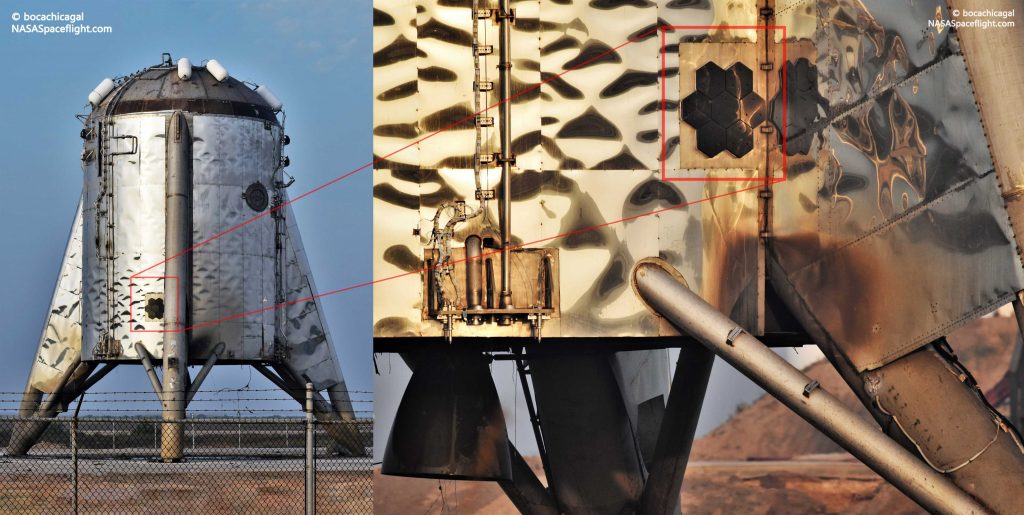
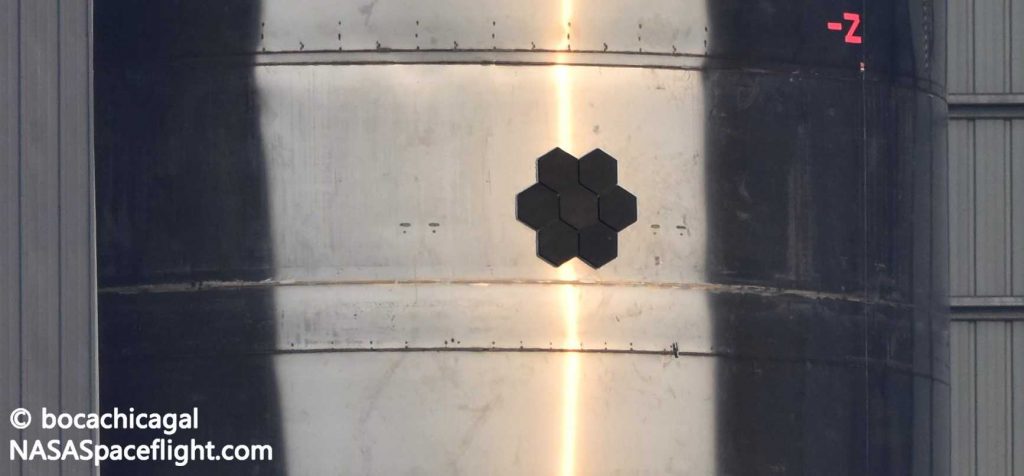
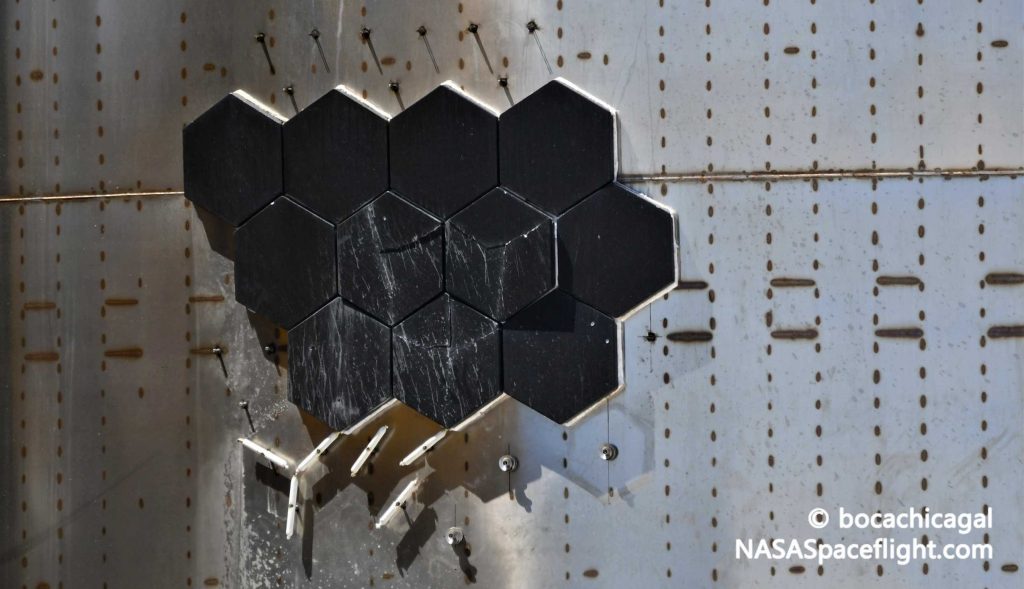
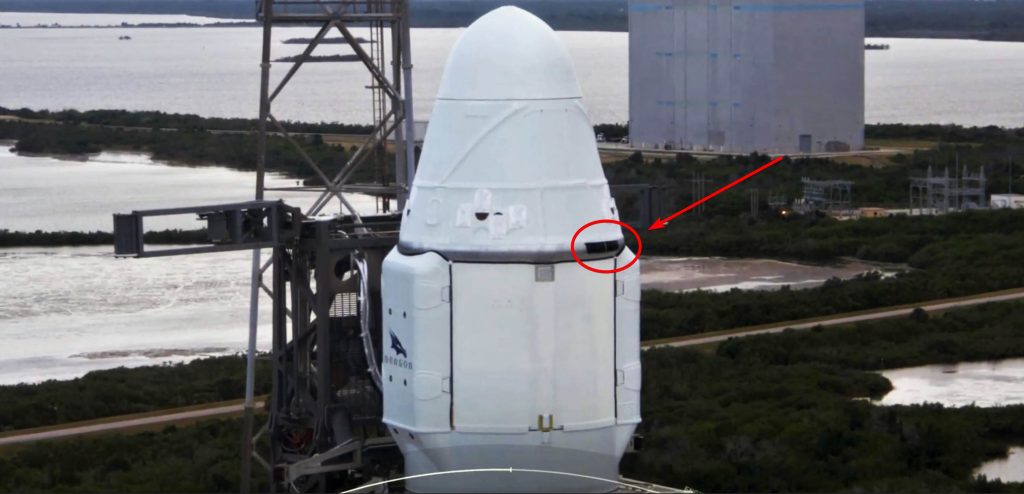
In 2019, SpaceX even tested a few ceramic Starship heat shield tiles on an orbital Cargo Dragon mission for NASA. The fact that no more orbital Cargo or Crew Dragon tests were acknowledged seems to suggest that the demonstration was a success, proving that the tiles can stand up to the stresses of reentry from low Earth orbit (LEO).
Behind the scenes, SpaceX is assuredly performing extensive laboratory-style tests with tiles and an agreement signed with NASA Ames Research Center confirmed that the company is using the facility’s arcjet to physically simulate the conditions of orbital-velocity reentry. Tests on the scale of a full Starship, however, are an entirely different story.
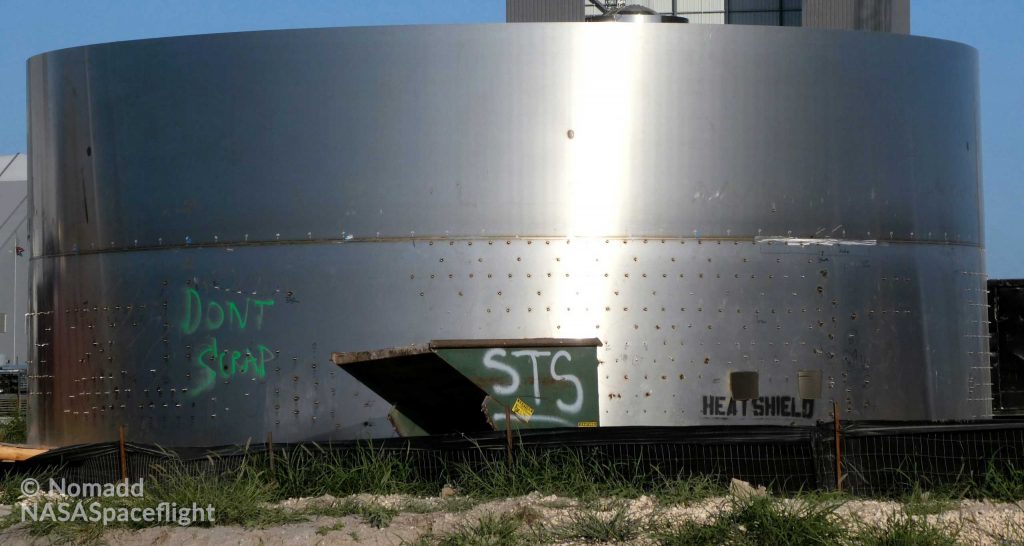
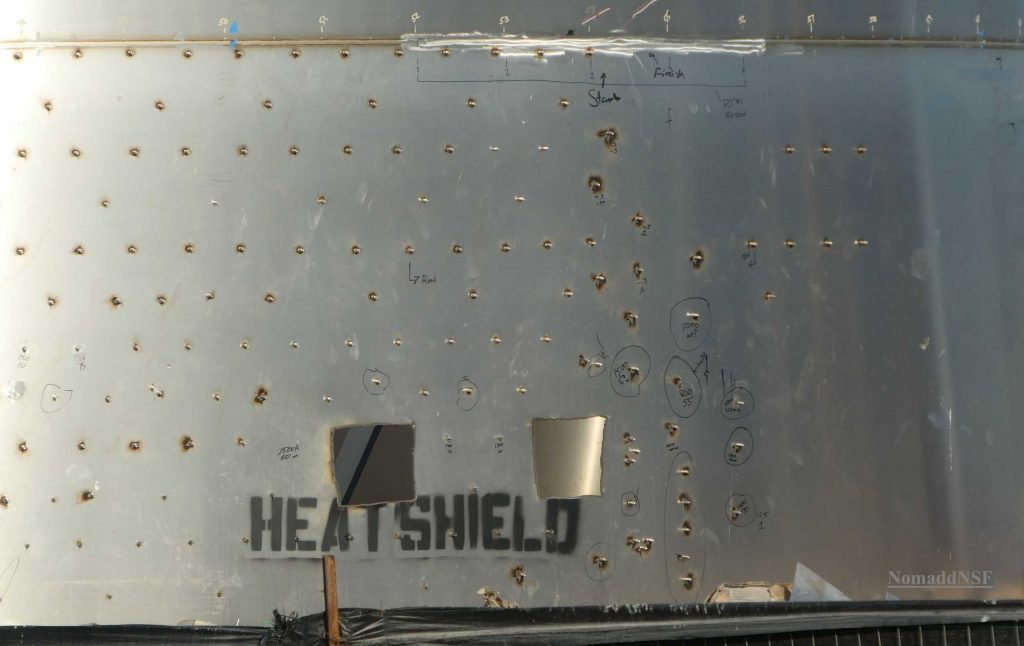
The first signs of large-scale heat shield installation testing appeared on July 9th when local resident and photographer Andrew Goetsch (Nomadd) captured photos of a test coupon covering half of an entire steel Starship ring. In April 2020, CEO Elon Musk confirmed on Twitter that the current design involved affixed heat shield tiles directly to Starship’s steel hull with steel studs. It’s unclear how exactly the company is installing steel studs directly onto the ~4mm (0.15 in) thick skins of a pressure vessel or if an off -the-shelf solution was available but Nomadd’s July 9th photos explicitly show the process required to refine the settings on the mystery stud installer.
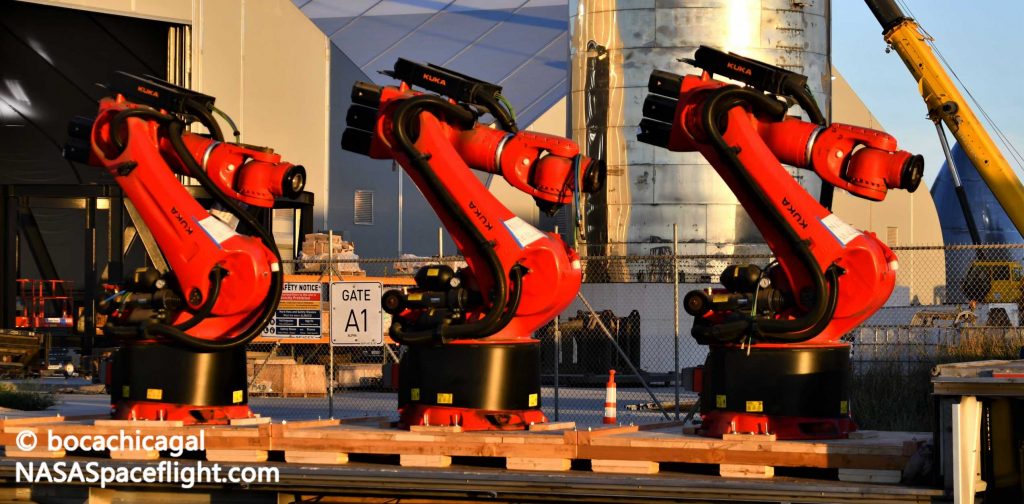
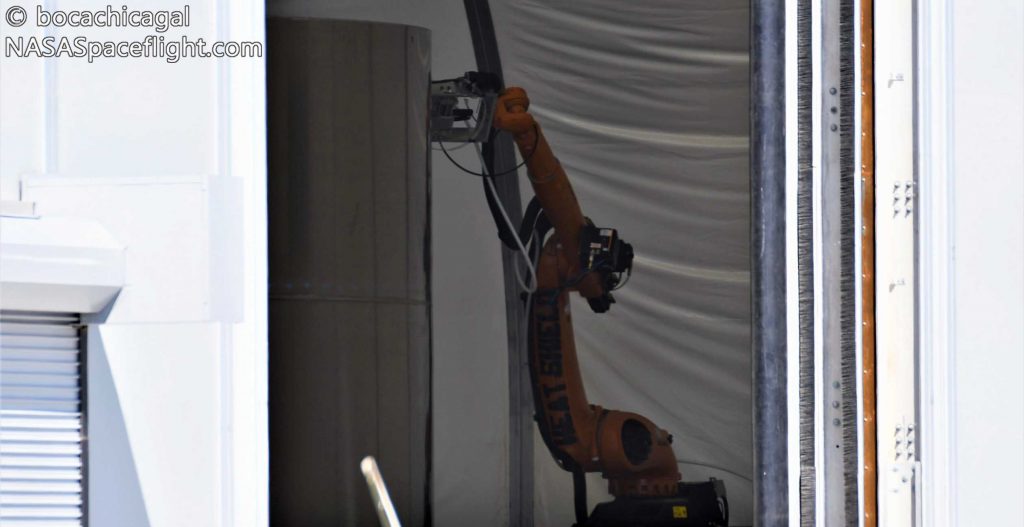
One month after Nomadd’s spotting, three weeks after a robot delivery, and five days after one of those robots – labeled “HEAT SHIELD – was spotted in action, the first large-scale heat shield installation test article was spotted inside one of SpaceX’s several production tents. The team involved clearly had some fun with the process, installing the tiles in the form of a SpaceX “X”.
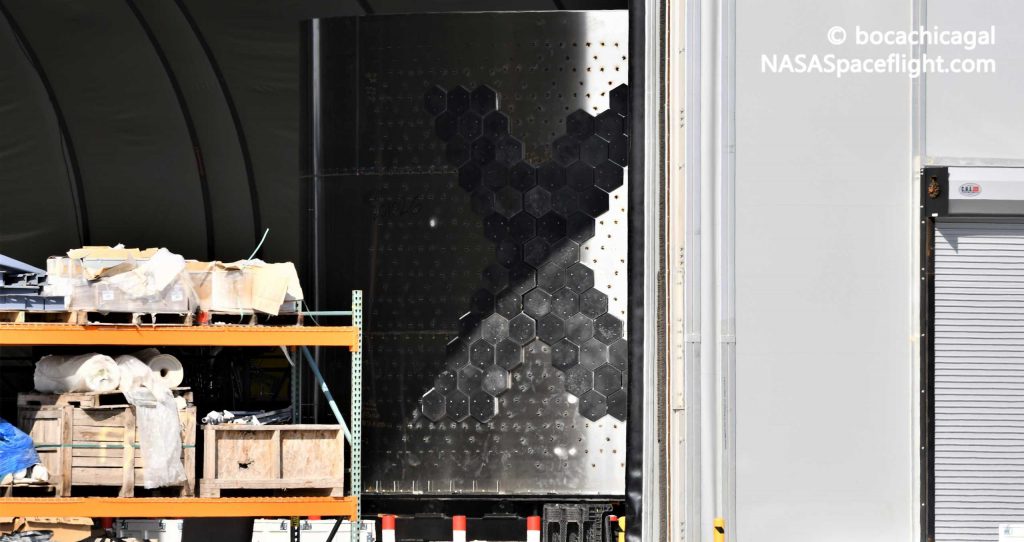
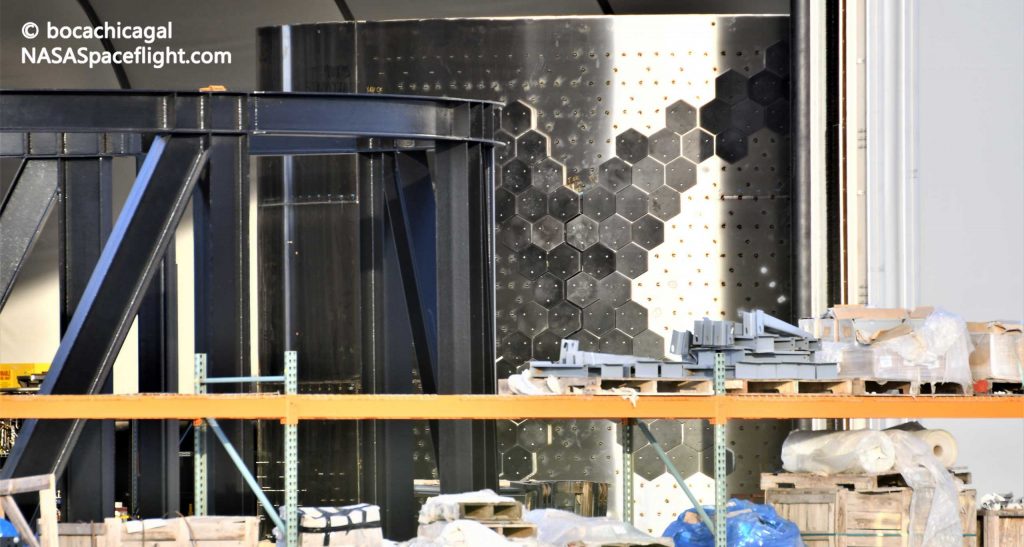
In retrospect, robots could be a perfect solution for the affordable, high-volume installation of the thousands of heat shield tiles a single Starship will need. Once tolerances are high enough, it’s conceivable that multiple different Starship sections could be individually outfitted with studs and heat shield tiles by robot, inspected by humans, and joined together to form a complete Starship. Humans would likely need to manually install a gap of tiles around the weld lines of those final sections, but the manual installation work would be reduced to a minimum while keeping the required infrastructure dead simple.
Ultimately, a great deal of work remains before SpaceX can even begin to feasibly attempt orbital Starship test flights, but it’s hard not to get excited by the fact that some of that preparatory work has already visibly begun in South Texas.
Check out Teslarati’s Marketplace! We offer Tesla accessories, including for the Tesla Cybertruck and Tesla Model 3.
News
These Tesla, X, and xAI engineers were just poached by OpenAI
The news is the latest in an ongoing feud between Elon Musk and the Sam Altman-run firm OpenAI.

OpenAI, the xAI competitor for which Elon Musk previously served as a boardmember and helped to co-found, has reportedly poached high-level engineers from Tesla, along with others from xAI, X, and still others.
On Tuesday, Wired reported that OpenAI hired four high-level engineers from Tesla, xAI, and X, as seen in an internal Slack message sent by co-founder Greg Brockman. The engineers include Tesla Vice President of Software Engineering David Lau, X and xAI’s head of infrastructure engineering Uday Ruddarraju, and fellow xAI infrastructure engineer Mike Dalton. The hiring spree also included Angela Fan, an AI researcher from Meta.
“We’re excited to welcome these new members to our scaling team,” said Hannah Wong, an OpenAI spokesperson. “Our approach is to continue building and bringing together world-class infrastructure, research, and product teams to accelerate our mission and deliver the benefits of AI to hundreds of millions of people.”
Lau has been in his position as Tesla’s VP of Software Engineering since 2017, after previously working for the company’s firmware, platforms, and system integration divisions.
“It has become incredibly clear to me that accelerating progress towards safe, well-aligned artificial general intelligence is the most rewarding mission I could imagine for the next chapter of my career,” Lau said in a statement to Wired.
🚨Optimistic projections point to xAI possibly attaining profitability by 2027, according to Bloomberg's sources.
If accurate, this would be quite a feat for xAI. OpenAI, its biggest rival, is still looking at 2029 as the year it could become cash flow positive.💰 https://t.co/pE5Z9daez8
— TESLARATI (@Teslarati) June 18, 2025
READ MORE ON OPENAI: Elon Musk’s OpenAI lawsuit clears hurdle as trial looms
At xAI, Ruddarraju and Dalton both played a large role in developing the Colossus supercomputer, which is comprised of over 200,000 GPUs. One of the major ongoing projects at OpenAI is the company’s Stargate program,
“Infrastructure is where research meets reality, and OpenAI has already demonstrated this successfully,” Ruddarraju told Wired in another statement. “Stargate, in particular, is an infrastructure moonshot that perfectly matches the ambitious, systems-level challenges I love taking on.”
Elon Musk is currently in the process of suing OpenAI for shifting toward a for-profit model, as well as for accepting an investment of billions of dollars from Microsoft. OpenAI retaliated with a counterlawsuit, in which it alleges that Musk is interfering with the company’s business and engaging in unfair competition practices.
Elon Musk confirms Grok 4 launch on July 9 with livestream event
News
SpaceX share sale expected to back $400 billion valuation
The new SpaceX valuation would represent yet another record-high as far as privately-held companies in the U.S. go.

A new report this week suggests that Elon Musk-led rocket company SpaceX is considering an insider share sale that would value the company at $400 billion.
SpaceX is set to launch a primary fundraising round and sell a small number of new shares to investors, according to the report from Bloomberg, which cited people familiar with the matter who asked to remain anonymous due to the information not yet being public. Additionally, the company would sell shares from employees and early investors in a follow-up round, while the primary round would determine the price for the secondary round.
The valuation would represent the largest in history from a privately-owned company in the U.S., surpassing SpaceX’s previous record of $350 billion after a share buyback in December. Rivaling company valuations include ByteDance, the parent company of TikTok, as well as OpenAI.
Bloomberg went on to say that a SpaceX representative didn’t respond to a request for comment at the time of publishing. The publication also notes that the details of such a deal could still change, especially depending on interest from the insider sellers and share buyers.
Axiom’s Ax-4 astronauts arriving to the ISS! https://t.co/WQtTODaYfj
— TESLARATI (@Teslarati) June 26, 2025
READ MORE ON SPACEX: SpaceX to decommission Dragon spacecraft in response to Pres. Trump war of words with Elon Musk
SpaceX’s valuation comes from a few different key factors, especially including the continued expansion of the company’s Starlink satellite internet company. According to the report, Starlink accounts for over half of the company’s yearly revenue. Meanwhile, the company produced its 10 millionth Starlink kit last month.
The company also continues to develop its Starship reusable rocket program, despite the company experiencing an explosion of the rocket on the test stand in Texas last month.
The company has also launched payloads for a number of companies and government contracts. In recent weeks, SpaceX launched Axiom’s Ax-4 mission, sending four astronauts to the International Space Station (ISS) for a 14-day stay to work on around 60 scientific experiments. The mission was launched using the SpaceX Falcon 9 rocket and a new Crew Dragon capsule, while the research is expected to span a range of fields including biology, material and physical sciences, and demonstrations of specialized technology.
News
Tesla Giga Texas continues to pile up with Cybercab castings
Tesla sure is gathering a lot of Cybercab components around the Giga Texas complex.

Tesla may be extremely tight-lipped about the new affordable models that it was expected to start producing in the first half of the year, but the company sure is gathering a lot of Cybercab castings around the Giga Texas complex. This is, at least, as per recent images taken of the facility.
Cybercab castings galore
As per longtime drone operator Joe Tegtmeyer, who has been chronicling the developments around the Giga Texas complex for several years now, the electric vehicle maker seems to be gathering hundreds of Cybercab castings around the factory.
Based on observations from industry watchers, the drone operator appears to have captured images of about 180 front and 180 rear Cybercab castings in his recent photos.
Considering the number of castings that were spotted around Giga Texas, it would appear that Tesla may indeed be preparing for the vehicle’s start of trial production sometime later this year. Interestingly enough, large numbers of Cybercab castings have been spotted around the Giga Texas complex in the past few months.
Cybercab production
The Cybercab is expected to be Tesla’s first vehicle that will adopt the company’s “unboxed” process. As per Tesla’s previous update letters, volume production of the Cybercab should start in 2026. So far, prototypes of the Cybercab have been spotted testing around Giga Texas, and expectations are high that the vehicle’s initial trial production should start this year.
With the start of Tesla’s dedicated Robotaxi service around Austin, it might only be a matter of time before the Cybercab starts being tested on public roads as well. When this happens, it would be very difficult to deny the fact that Tesla really does have a safe, working autonomous driving system, and it has the perfect vehicle for it, too.
-

 Elon Musk1 week ago
Elon Musk1 week agoTesla investors will be shocked by Jim Cramer’s latest assessment
-

 News2 weeks ago
News2 weeks agoTesla Robotaxi’s biggest challenge seems to be this one thing
-

 Elon Musk1 day ago
Elon Musk1 day agoElon Musk confirms Grok 4 launch on July 9 with livestream event
-

 News2 weeks ago
News2 weeks agoWatch the first true Tesla Robotaxi intervention by safety monitor
-

 News5 days ago
News5 days agoTesla Model 3 ranks as the safest new car in Europe for 2025, per Euro NCAP tests
-

 Elon Musk2 weeks ago
Elon Musk2 weeks agoA Tesla just delivered itself to a customer autonomously, Elon Musk confirms
-

 Elon Musk2 weeks ago
Elon Musk2 weeks agoxAI welcomes Memphis pollution results, environmental groups push back
-

 Elon Musk2 weeks ago
Elon Musk2 weeks agoElon Musk confirms Tesla Optimus V3 already uses Grok voice AI

















